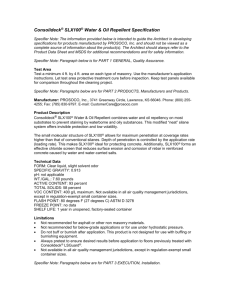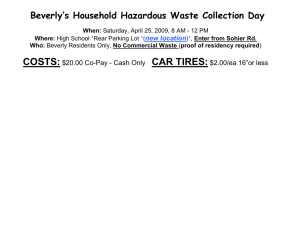04900 Restoration 0306 final - Mason Contractors Association
advertisement
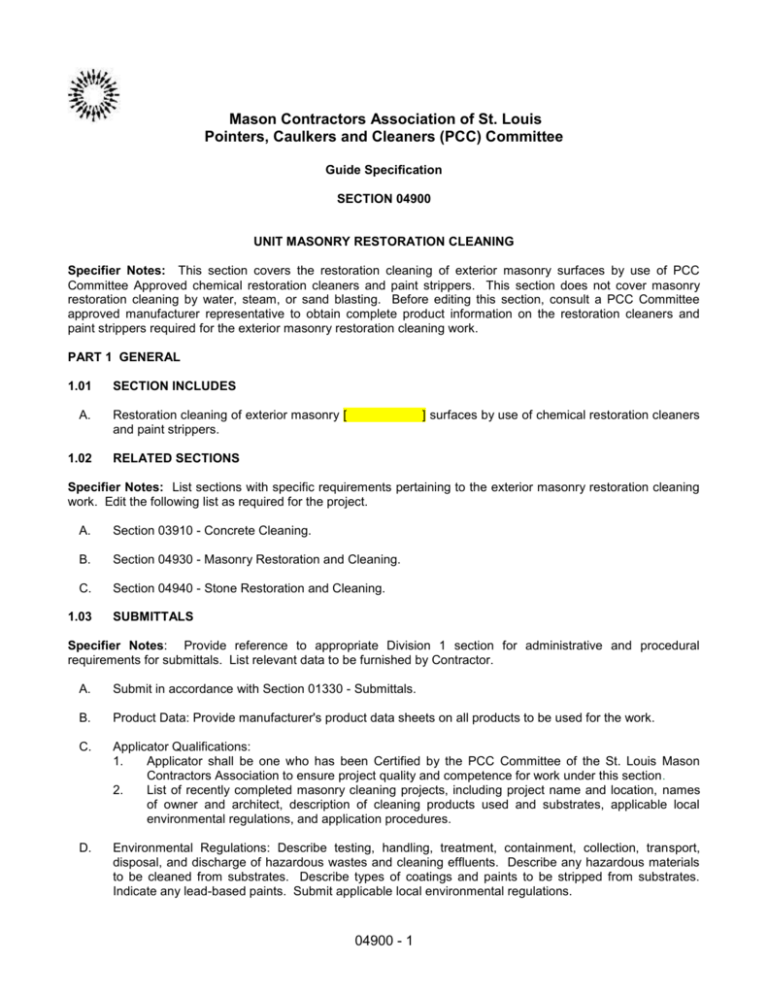
Mason Contractors Association of St. Louis Pointers, Caulkers and Cleaners (PCC) Committee Guide Specification SECTION 04900 UNIT MASONRY RESTORATION CLEANING Specifier Notes: This section covers the restoration cleaning of exterior masonry surfaces by use of PCC Committee Approved chemical restoration cleaners and paint strippers. This section does not cover masonry restoration cleaning by water, steam, or sand blasting. Before editing this section, consult a PCC Committee approved manufacturer representative to obtain complete product information on the restoration cleaners and paint strippers required for the exterior masonry restoration cleaning work. PART 1 GENERAL 1.01 A. 1.02 SECTION INCLUDES Restoration cleaning of exterior masonry [ and paint strippers. ] surfaces by use of chemical restoration cleaners RELATED SECTIONS Specifier Notes: List sections with specific requirements pertaining to the exterior masonry restoration cleaning work. Edit the following list as required for the project. A. Section 03910 - Concrete Cleaning. B. Section 04930 - Masonry Restoration and Cleaning. C. Section 04940 - Stone Restoration and Cleaning. 1.03 SUBMITTALS Specifier Notes: Provide reference to appropriate Division 1 section for administrative and procedural requirements for submittals. List relevant data to be furnished by Contractor. A. Submit in accordance with Section 01330 - Submittals. B. Product Data: Provide manufacturer's product data sheets on all products to be used for the work. C. Applicator Qualifications: 1. Applicator shall be one who has been Certified by the PCC Committee of the St. Louis Mason Contractors Association to ensure project quality and competence for work under this section. 2. List of recently completed masonry cleaning projects, including project name and location, names of owner and architect, description of cleaning products used and substrates, applicable local environmental regulations, and application procedures. D. Environmental Regulations: Describe testing, handling, treatment, containment, collection, transport, disposal, and discharge of hazardous wastes and cleaning effluents. Describe any hazardous materials to be cleaned from substrates. Describe types of coatings and paints to be stripped from substrates. Indicate any lead-based paints. Submit applicable local environmental regulations. 04900 - 1 Mason Contractors Association of St. Louis Pointers, Caulkers and Cleaners (PCC) Committee E. Protection: Describe methods for protecting surrounding areas, landscaping, building occupants, pedestrians, vehicles, and nonmasonry surfaces during the work from contact with chemical restoration cleaners and paint strippers, residues, rinse water, fumes, wastes, and cleaning effluents. F. Surface Preparation: Describe surface preparation to be completed before application of restoration cleaners and paint strippers. G. Application: Describe application procedures of restoration cleaners and paint strippers. 1.04 A. QUALITY ASSURANCE Applicator Qualifications: 1. Applicator shall be Certified by the PCC Committee of the St. Louis Mason Contractors Association. 2. Employs persons trained for the application of the specified products. Specifier Notes: Describe requirements for a meeting to coordinate the masonry cleaning work and to sequence related work. B. 1.05 Pre-Application Meeting: Convene a pre-application meeting [ ] weeks before the start of masonry cleaning. Require attendance of parties directly affecting work of this section, including the Contractor, Architect, applicator, and cleaning material manufacturers representative. Review environmental regulations, test panel procedures, protection of surrounding areas and non-masonry surfaces, surface preparation, application, field quality control, final cleaning, and coordination with other work. ENVIRONMENTAL REGULATIONS Specifier Notes: Consider federal, state, and local environmental regulations regarding the testing, handling, treatment, containment, collection, transport, disposal, and discharge of hazardous wastes and cleaning effluents. When cleaning masonry substrates, consider if any hazardous materials or compounds will be removed. When stripping paint, consider the type of paint being removed. Older paints may be toxic, containing asbestos, lead, or other heavy metals. Contact manufacturer for additional information. A. 1.06 Comply with applicable federal, state, and local environmental regulations regarding testing, handling, treatment, containment, collection, transport, disposal, and discharge of hazardous wastes and cleaning effluents. TEST PANELS A. Before full-scale application, review manufacturer's product data sheets to determine the suitability of each product for the specific surfaces. Apply each restoration cleaner and paint stripper to test panels to determine dilution rates, dwell times, number of applications, compatibility, effectiveness, application procedures, effects of pressure rinsing, and desired results. B. Apply restoration cleaners and paint strippers to test panels in accordance with manufacturer's instructions. Allow 48 hours or until test panels are thoroughly dry, before evaluating final appearance and results. Do not begin full-scale application until test panels are inspected and approved by the Architect. 1. Size: Minimum 4 feet by 4 feet each. 2. Locations: As determined by the Architect. 3. Restoration Cleaners: Number of test panels as required to completely test each restoration cleaner with each type of substrate and with each type of material or stain to be cleaned. 04900 - 2 Mason Contractors Association of St. Louis Pointers, Caulkers and Cleaners (PCC) Committee 4. Paint Strippers: Number of test panels as required to completely test each paint stripper with each type of substrate and with each type of coating or paint to be stripped. C. Test all cleaning effluents generated by the restoration cleaning and paint stripping of the test panels to determine any hazardous characteristics. Comply with applicable federal, state, and local environmental regulations regarding testing, handling, treatment, containment, collection, transport, disposal, and discharge of hazardous wastes. D. Retain and protect approved test panels in undisturbed condition during the work of this section, as a standard for judging the restoration cleaning work. 1.07 DELIVERY, STORAGE, AND HANDLING A. Delivery: Deliver materials to site in manufacturer's original, unopened containers and packaging, with labels clearly identifying product name and manufacturer. B. Storage and Handling: Store containers upright in a cool, dry, well ventilated place, out of the sun. Store away from all other chemicals and potential sources of contamination. Keep lights, fire, sparks, and heat away from containers. Do not drop onto or slide across sharp objects. Keep containers tightly closed when not in use. Store and handle materials in accordance with manufacturer's instructions. 1.08 PROJECT CONDITIONS Specifier Notes: Establish physical and environmental limitations or criteria. Such conditions might include air and surface temperatures, weather, wind, and ventilation required for proper application. Describe condition of existing structures or buildings subject to restoration cleaning. A. Do not clean masonry surfaces when temperatures are below freezing or will be overnight, to avoid harm to masonry. Clean masonry surfaces only when air and masonry surface temperatures are 40F and above. Allow adequate time for masonry to thaw if freezing conditions exist prior to application. PART 2 PRODUCTS 2.01 MANUFACTURER A. PCC Approved Restoration Cleaner Manufacturer 1. PROSOCO, Inc., 3741 Greenway Circle, Lawrence, KS 66046, (800) 255-4255, (785) 865-4200. a. Mr. Mike Dickey 2. DIEDRICH TECHNOLOGIES, INC. Technologies, 7373 S. 6th St, Oak Creek, WI 53154, (800) 323-3565, (414) 764-6993 a. Ms. Dianna Johnson 2.02 RESTORATION CLEANERS Specifier Notes: Refer to approved manufacturer product data sheets or contact an approved product representative to determine the appropriate restoration cleaners to be used. Edit this list of restoration cleaners to include only those products and substrates to be included in the work. 04900 - 3 Mason Contractors Association of St. Louis Pointers, Caulkers and Cleaners (PCC) Committee A. General-purpose acidic restoration cleaner for brick, terra cotta, sandstone, granite, and many other masonry surfaces. Dissolves heavy atmospheric soiling. Not suitable for limestone, marble, travertine, concrete, or cast stone surfaces. B. Heavy Duty HIGH GRADE Restoration Cleaner: Concentrated, general-purpose acidic restoration cleaner for brick, terra cotta, sandstone, granite, and many other masonry surfaces. Dissolves heavy atmospheric soiling. Not suitable for limestone, marble, travertine, concrete, or cast stone surfaces. C. Light Duty LIGHT GRADE Restoration Cleaner: Acidic restoration cleaner for concrete, brick, tile, terra cotta, pavers, polished granite and unpolished marble, travertine, limestone, granite, sandstone and slate.. Not intended for regular maintenance cleaning of glass. Removes light to moderate atmospheric and oxidation staining from dense masonry surfaces. D. Limestone and Masonry Prewash: Non-acidic alkaline gel for dissolving heavy carbon soiling from masonry surfaces. General purpose cleaner for very dirty surfaces. Spot cleaner for beneath windowsills or on other heavily stained areas. Safe for most unpolished limestone, marble, travertine, concrete, and cast stone surfaces. Effective on heavily soiled brick, terra cotta, sandstone, granite, and most other masonry. Neutralize treated surfaces. E. Limestone and Masonry Afterwash: Mild, acidic after-wash to neutralize surfaces prewashed with alkaline cleaners. F. Limestone Restorer is a concentrated acidic cleaner for unpolished limestone, concrete and cast stone surfaces. Safely removes atmospheric dirt, mildew and many other surface stains without risk of bleaching or discoloration. Ideal for lightly to moderately soiled surfaces. G. For removal of biological and atmospheric staining from vertical or horizontal masonry surfaces. Cleans difficult mold and mildew staining that blackens limestone, marble, concrete and other masonry surfaces in humid environments. PAINT STRIPPERS Specifier Notes: Refer to manufacturers product data sheets or contact a manufacturers representative to determine the appropriate paint strippers to be used. Edit this list of paint strippers to include only those products and substrate to be included in the work. A Heavy Duty Paint Stripper, an alkaline formula with organic solvents, removes multiple layers of paint and graffiti from masonry surfaces. This “slow-working,” extended-contact remover, remains active for 24 hours. One application of Heavy Duty Paint Stripper dissolves heavy accumulations of paint, most spray paint, lacquers and graffiti, restoring old masonry to its original appearance. Heavy Duty Paint Stripper contains no methanol, methylene chloride, or chlorinated solvents, and is water rinsable and nonflammable. 1. Form: gel 2. Color: Light brown 3. pH: 14 4. Specific Gravity: 1.27 5. Flash Point: <2000F 04900 - 4 Mason Contractors Association of St. Louis Pointers, Caulkers and Cleaners (PCC) Committee A. Fast Acting Stripper is a thixotripic stripping compound designed for removing coatings and epoxies from masonry, wood and metal surfaces. It also removes oil, grease and waxes from concrete decks, tile and terrazzo floors. 1. Form: gel 2. Color: clear 3. pH: N/A 4. Specific Gravity: 1.20 5. Flash Point: 950F B. Safety Peel is a solvent paste with a mild citrus odor that contains no methylene chloride or methanol. Designed for removal of paint, graffiti and clear coatings, Safety Peel is a “slow-working” paint remover. Usually just one application dissolves multiple layers. Safety Peel reduces environmental and applicator risks associated with use of conventional chemical paint removers. Used properly, Safety Peel substantially reduces the volume of waste. Potentially hazardous paint solids are trapped in the semi-dry paste, which is then “peeled” from the surface, simplifying containment and disposal. 1. Form: Paste 2. Color: Light Green 3. Specific Gravity: 1.24 4. Flash Point:1570F C. Paste containing potassium hydroxide, is formulated to simplify rinsing and neutralization requirements. Reduces the volume of waste generated by conventional liquid and paste removal systems. Formulated as a “slow working” paint remover, removes heavy accumulations of paint and graffiti from masonry, concrete, plaster, steel, and many wood surfaces. One application dissolves multiple layers of many common paint coating enabling them to be removed in a controlled manner. Potentially hazardous paint solids are trapped in the semi-dry past, simplifying their containment and disposal. 1. Form: Paste 2. Color: Beige 3. pH: 14 4. Specific Gravity: 1.247 5. Flash Point: N/A D. Solvent paste with a mild citrus odor that contains no methylene chloride or methanol. Designed for removal of paint, graffiti and clear coatings. One application dissolves multiple paint layers for controlled removal. Formulated to reduce environmental and applicator risks associated with use of conventional chemical paint removers. Used properly, it substantially reduces the volume of waste. Potentially hazardous paint solids are trapped in the semi-dry paste, simplifying containment and disposal. 1. Form: Paste 2. Color: Brown 3. pH: N/A 4. Specific Gravity: 1.330 5. Flash Point: 1110F PART 3 EXECUTION 3.01 EXAMINATION Specifier Notes: State actions required to determine that conditions are acceptable to receive the chemical restoration cleaners and paint strippers specified. 04900 - 5 Mason Contractors Association of St. Louis Pointers, Caulkers and Cleaners (PCC) Committee A. 3.02 Verify by examination that masonry surfaces are acceptable to receive the specified restoration cleaners and paint strippers. PROTECTION Specifier Notes: State requirements for protecting the surrounding areas and all nonmasonry surfaces during the chemical restoration cleaning and paint stripping work. A. Protect surrounding areas, landscaping, building occupants, pedestrians, vehicles, and nonmasonry surfaces during the work from contact with chemical restoration cleaners and paint strippers, residues, rinse water, fumes, wastes, and cleaning effluents in accordance with manufacturer's instructions. B. Clean masonry before installation of replacement windows. C. Test window glass not specified to be replaced for compatibility with chemical cleaning products to determine required protection. D. Divert and protect pedestrian and auto traffic. E. Avoid wind drifting of spray of chemical cleaning products, residues, and rinse water. 3.03 SURFACE PREPARATION Specifier Notes: Describe surface preparation of substrates required prior to application of restoration cleaners and paint strippers. A. 3.04 Apply all specified caulking and sealants and allow to cure before chemical cleaning begins. APPLICATION OF RESTORATION CLEANERS Specifier Notes: Refer to Article 1.06 TEST PANELS and to approve manufacturers product data sheets to determine appropriate application procedures for the restoration cleaners and substrates specified in PART 2 PRODUCTS. A. 3.05 General: Apply restoration cleaners to substrates in accordance with manufacturer's instructions, environmental regulations, and application procedures determined from test panel results approved by the Architect. Consult manufacturer's instructions for information on equipment to be used and precautions to be taken with the specified products. APPLICATION OF PAINT STRIPPERS Specifier Notes: Refer to Article 1.06 TEST PANELS and to PROSOCO and DIEDRICH TECHNOLOGIES product data sheets to determine appropriate application procedures for the paint strippers and substrates specified in Part 2 Products. A. General: Apply paint strippers to dry substrates in accordance with manufacturer’s instructions, environmental regulations, and application procedures determined from test panel results approved by the Architect. Consult manufacturer’s instructions for information on equipment to be used and precautions to be taken with the specified products. 04900 - 6 Mason Contractors Association of St. Louis Pointers, Caulkers and Cleaners (PCC) Committee 3.06 FIELD QUALITY CONTROL Specifier Notes: Define the inspections during and at completion of restoration cleaning work, to determine if the substrates are suitably prepared to start masonry restoration. A. Inspection: Inspect the restoration cleaning work with the Contractor, Architect, applicator, and an approved manufacturers representative, and compare with approved test panels. Determine if the substrates are suitably prepared to start masonry restoration. Specifier Notes: Describe specific requirements if manufacturer is to provide field quality control with on-site personnel for instruction or supervision of test panels, protection, surface preparation, and application of chemical restoration cleaners and paint strippers. B. 3.07 Manufacturer's Field Services: Provide the services of a manufacturer's authorized field representative to verify specified products are used, and to ensure test panels, protection, surface preparation, and application of restoration cleaners and paint strippers are in accordance with manufacturer's instructions. FINAL CLEANING Specifier Notes: Describe final actions to clean site and to remove materials used to protect surrounding areas and nonmasonry surfaces. A. Clean site of all unused chemical cleaning products, residues, rinse water, wastes, and cleaning effluents in accordance with environmental regulations. B. Remove and dispose of all materials used to protect surrounding areas and nonmasonry surfaces, following completion of the work of this section. 3.08 SCHEDULE Specifier Notes: When appropriate, include a schedule indicating locations, substrates, and work sequence of restoration cleaning and paint stripping, if not indicated on the drawings. END OF SECTION 04900 - 7
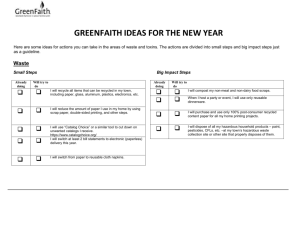
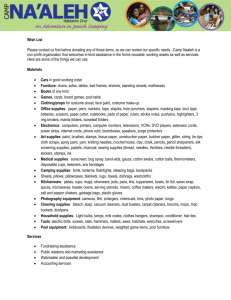
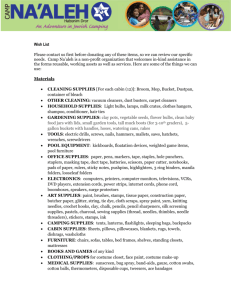
![[Agency] recognizes the hazards of lead](http://s3.studylib.net/store/data/007301017_1-adfa0391c2b089b3fd379ee34c4ce940-300x300.png)

